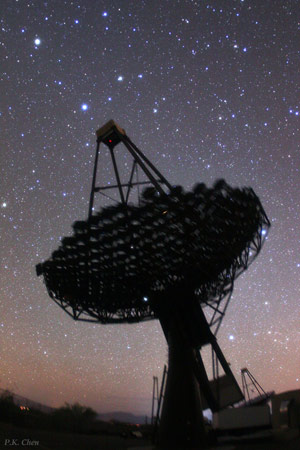
Telescopes of the VERITAS (Very Energetic Radiation Imaging Telescope Array System) gamma-ray observatory are photographed against the stars of constellation Leo. Astronomers have used VERITAS to study a source of gamma-ray emission that has no known counterpart at other wavelengths. Credit: P.K. Chen
Using the VERITAS gamma-ray telescope, astronomers studied a mysterious VHE gamma-ray source from the constellation of Cygnus that has no known counterpart at other wavelengths.
Gamma-rays are the most energetic known form of electromagnetic radiation, with each gamma ray being at least one hundred thousand times more energetic than an optical light photon. The most potent gamma rays, the so-called VHE (very high energy) gamma rays, pack energies a billion times this amount, or even more. Astronomers think that VHE gamma rays are produced in the environment of the winds or jets of the compact, ultra-dense remnant ashes of massive stars left behind from supernova explosions.
There are two kinds of compact objects produced in supernovae: black holes and neutron stars (stars made up predominantly of neutrons, having densities equivalent to the mass of the Sun packed into a volume about 10 kilometers in radius). The winds or jets from the environments of such objects, including the kind called pulsars, can accelerate charged particles to very close to the speed of light. When light scatters off such energetic particles it becomes energized as well, sometimes turning into VHE gamma rays. At least this is the most popular current theory. One of the first known VHE sources was spotted about fifteen years ago in the direction of the constellation of Cygnus. It was unusual because, unlike most other known VHE sources which had counterparts seen at optical, radio, or other wavelengths, this new source had no known counterpart. With no other information available, its exact nature was mysterious.
Recently a pulsar was discovered in the general vicinity, renewing interest in the source. CfA astronomers Wystan Benbow, Matteo Cerruti, Pascal Fortin, Nicola Galante, Emmet Thomas, and Trevor Weekes along with a large team of colleagues tackled the puzzle using the VERITAS gamma-ray telescope at the Fred L. Whipple Observatory in Arizona. They obtained very long, sensitive observations of the VHE source in Cygnus, and for the first time were able to refine the location and determine that the emission was not point-like but slightly extended and asymmetric in shape. The astronomers conclude for several reasons that the newly found pulsar is probably not the origin of the VHE emission.
Remarkably, even with the refined location, images at other wavelengths reveal no point sources. In the infrared images, however, the region can be characterized by the fact that it lacks any dust emission and so appears dark while its surroundings glow with cool dust emission. The dark region is nearly the same shape as the gamma-ray region, making the source even more mysterious than before. However, if the object were a faint pulsar whose wind produced VHE gamma-rays, it might, in some scenarios, also have blown away all the local dust to clear a void like the one seen in the infrared. More work is needed to understand this intriguing object but the current work, with its sensitivity and spatial resolution results, represents an important advance in the field of gamma-ray astronomy.
Reference: “Observations of the Unidentified Gamma-Ray Source TeV J2032+4130 BY VERITAS” by VERITAS Collaboration: E. Aliu, T. Aune, B. Behera, M. Beilicke, W. Benbow, K. Berger, R. Bird, J. H. Buckley, V. Bugaev, J. V Cardenzana, M. Cerruti, X. Chen, L. Ciupik, M. P. Connolly, W. Cui, C. Duke, J. Dumm, M. Errando, A. Falcone, S. Federici, Q. Feng, J. P. Finley, P. Fortin, L. Fortson, A. Furniss, N. Galante, G. H. Gillanders, S. Griffin, S. T. Griffiths, J. Grube, G. Gyuk, D. Hanna, J. Holder, G. Hughes, T. B. Humensky, O. Kargaltsev, P. Kaaret, M. Kertzman, Y. Khassen, D. Kieda, H. Krawczynski, M. J. Lang, A. S Madhavan, G. Maier, P. Majumdar, A. McCann, P. Moriarty, R. Mukherjee, D. Nieto, A. O’Faolain de Bhroithe, R. A. Ong, A. N. Otte, D. Pandel, J. S. Perkins, M. Pohl, A. Popkow, H. Prokoph, J. Quinn, K. Ragan, J. Rajotte, L. C. Reyes, P. T. Reynolds, G. T. Richards, E. Roache, G. H. Sembroski, C. Skole, D. Staszak, I. Telezhinsky, M. Theiling, J. V. Tucci, J. Tyler, A. Varlotta, S. Vincent, S. P. Wakely, T. C. Weekes, A. Weinstein, R. Welsing, D. A. Williams and B. Zitzer, 7 February 2014, The Astrophysical Journal.
DOI: 10.1088/0004-637X/783/1/16
arXiv:1401.2828

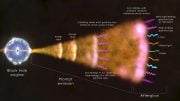
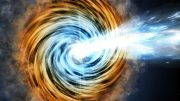
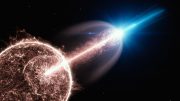

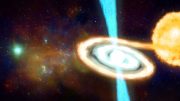
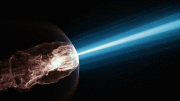
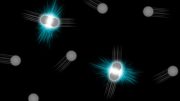
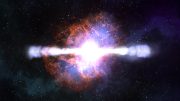
Be the first to comment on "Researchers Study Mysterious Gamma Ray Source with No Known Counterpart"